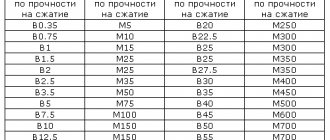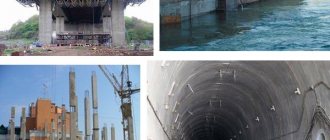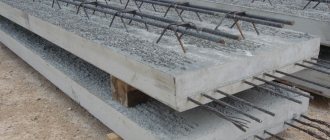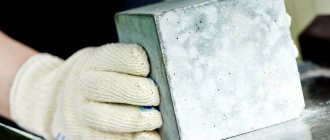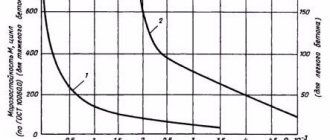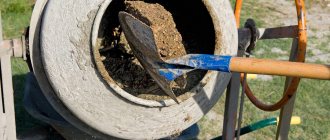Determination of concrete strength non-destructively
No matter how high-quality the raw materials are, and even if the ideal selection of composition is found, it is extremely necessary to systematically determine the strength of concrete: GOST 10180 - 2012, GOST 22690 - 2015, GOST 18105 - 2010, GOST 28570 - 90 and other technical documentation will help not only test, but also correctly calculate the obtained data of similar characteristics.
The many faces of concrete strength
Concrete sample during testing
The concept of concrete strength is quite broad.
There are several types of concrete strength:
- Design - allows full load on concrete of the selected grade. By default, the product should have a similar value after standard testing of the sample at 28 days of age with natural aging.
- Normalized is determined according to regulatory documents and standards.
- Required - symbolizes the minimum value that is allowed under the designed loads. Detected in construction laboratories.
- Actual - strength that is immediately recognizable during the testing process. This is precisely the vacation pay - at least 70% of the project amount.
- Stripping - the value of this characteristic shows when it is possible to strip samples or products without deformation.
Concrete sample testing
In the generally accepted sense, strength means cubic strength in compression.
But in particularly narrow circles of concrete workers, they always clarify exactly what quality characteristic they are dealing with:
- for compression;
- to bend;
- for axial tension;
- transmission
Let's take a closer look at each of them separately.
Compressive strength
The cube strength of concrete is traditionally taken as the basis for concrete marking. Its values are obtained by testing cube-shaped samples with rib dimensions of 150x150 mm on a press at 28 days of age. This value is recognized as a reference value for determining the resistance of concrete to axial compression.
Samples of other sizes may also be used. According to the change in scale, the data obtained varies.
In this case, additional calculations are given that equalize the obtained values to cubic ones. This is done quite simply: the values are multiplied by the scale factor C, the value of which can be found out from GOST 10180 - 2012.
Cubic sample with edge size 150 cm
Despite the fact that all large factories carry out just such standard tests on cubic specimens, the main strength for compressed concrete elements is the prismatic strength (RB). It shows lower values than when testing standard samples with a 150 mm rib (R). Interestingly, as the ratio of the height (h) to the area of the base of the prism (a) increases, the strength decreases.
At h/a=4 the strength value becomes relatively stable. Therefore, prismatic strength is considered as temporary resistance to axial compression at an aspect ratio of h/a=4.
The graph shows the dependence of prismatic strength on changes in sample dimensions
If prismatic strength more accurately reflects the main characteristics of concrete samples, then why is only cubic strength used? The answer to such an ambiguous question is quite simple.
Attention! The strength of a concrete sample is influenced by many factors, the key of which are the raw materials themselves, the selection of the composition, and curing conditions. But a sample can also show “poor” strength due to poor compaction. And this, unfortunately, is not uncommon.
Compacted concrete samples
If there is no such problem with more flexible mixtures, then it is physically difficult to make a well-compacted sample from hard concrete in laboratory conditions. For this reason, in order not to distort the obtained values due to the human factor, it is customary to consider cubic strength to be the main one. Although when designing reinforced concrete structures, it is prismatic strength that is used.
Bending tensile strength
Device for determining the tensile strength of concrete in bending
The main task of concrete of any brand is to withstand any compressive loads. This is precisely his strength. Therefore, such a characteristic as the tensile strength of concrete in bending is rarely used in “construction and industrial use.” Similar indicators are applicable for design work.
Therefore, determining the tensile strength of a concrete mixture in bending is a rather rare test in any construction laboratory, since it is quite difficult to create the necessary loads for the sample. Therefore, such characteristics are more calculated. Designers use numbers and values long ago derived at design institutes.
Transfer strength
Device for tensioning concrete products
There is such a thing as the transfer strength of concrete. At a construction site, such terminology is not used, and foremen do not always understand “what it is and what it is eaten with.” This definition is purely industrial, which denotes the strength of concrete at the moment of compression when transferring the stress of the reinforcement to the concrete.
This is an important characteristic, without which it is impossible to produce any prestressed product with high quality. This value is standardized in design documentation and other technical documents for the reinforced concrete product being manufactured. Usually it is assigned no lower than 70% of the design strength.
How to determine the strength of concrete? Yes, very simple.
To do this, use a simple formula for determining the strength of concrete transfer:
- Rbp = 0.7B,
- Where: Rbp - transfer strength;
- B—design strength;
- 0.7 is an unchangeable coefficient.
Attention! If the test value satisfies the calculated value, then it is recommended to remove the product from voltage. If not, then at the discretion of the technologist or head of the laboratory, a decision is made to extend the prestressing time of the product.
Methods for monitoring unhardened mortar
They are used during the preparation process or after mixing the solution.
Cone settlement method
By analyzing the measurement of the cone slump, the heterogeneity and consistency of the mixture of the nominal composition is determined. This has implications for the workability of the mortar, although the slump itself is not always related to it.
The settling parameters of the cone may mean, for example, that the amount of moisture in the aggregate has increased, but also that its granulometric composition has changed or there is not enough sand.
Compaction test
The method is carried out using an apparatus consisting of two containers with funnels. The solution is carefully poured into one without compacting it, the valve opens at the bottom, the mixture flows into another, smaller container, from which it falls into a cylindrical shape. The density of the mixture in the cylinder is calculated mathematically. In this way the compaction coefficient is determined.
Plasticity control and shape change
Concrete is poured into a test truncated cone, which is placed on a special table that can drop several centimeters when shaken.
Then the form is removed, the table is lowered with pushes - the concrete mixture spreads over it. The average diameter of the spreading solution is measured.
Air presence measurement
There are three methods for measuring the presence of air in a solution. The first method is weight. It is very simple: the weight of the mixture is measured before and after shaking and mixing in a container (pycnometer). Very precise weighing instruments are used here.
The second is the pressure method; it is not used for mixtures with porous aggregates. Special air meters are used here; they show the percentage composition of the air. The reduction in volume of a sample is measured at a known pressure, which is created by a test press or pump and indicated by a pressure gauge. As the pressure increases, the volume of air in the solution increases, which lowers the water level above the sample. The air content of the hardened material is measured on polished sections under a chord-counting microscope or a high-pressure air meter.
Instruments and equipment for determining the strength of concrete
Instruments for non-destructive testing of concrete strength
Today, there are various methods for determining the strength of concrete.
Depending on them, the required devices are used:
- A press is standard equipment in any construction laboratory. There are different operating principles, but the most reliable and popular is hydraulic. There are many models and types of such equipment. With the help of some, you can only test concrete samples: cubes for compression and tension of cement beams. Others are expanding their use to testing large blocks, bricks and other materials. You can use it to determine the strength of concrete in just a couple of minutes, you just need to know how to work with it and record the required values.
Press for determining the strength of concrete
- Devices for determining the strength of concrete using a non-destructive method have gained unprecedented popularity today. Using a sclerometer, you can check the strength of concrete structures during inspection in objects under construction, and in buildings that have been put into operation for a long time. There is no need to cut cubes out of the array. Everything is done much easier. At the same time, the price of such devices is quite high - depending on the type and functions that the device has for determining the strength of concrete using a non-destructive method. You can test the required design yourself, without the help of specialists. You just need to strictly follow all the parameters provided in the instructions for use. You can see more details on how to use a sclerometer in the video in this article.
- Another device designed to identify the main characteristics is a hammer for determining the strength of concrete. Before the widespread use of glass meters, Kashkarov’s standard hammer was constantly used on construction sites and in laboratories. The bounce test is quite difficult to perform. This method of determining the strength of concrete requires a certain skill and knowledge. 229690-88 GOST for determining the strength of concrete using non-destructive methods will allow you to navigate in this area. But it is best to master elastic rebound in practice - this way you have a better chance of learning how to perform such testing correctly.
The photo shows Kashkarov's hammer
Concrete frost resistance class
The higher the class of concrete, the greater the degree of frost resistance it has. Frost resistance of these mixtures is their ability to retain their properties after several cycles of alternating freezing and thawing. Thus, class B7.5 concrete can withstand 50 such cycles, and B40 concrete can withstand up to 300 cycles. Below is a table showing the correspondence between the class of concrete and the degree of its frost resistance.
| Concrete mix class | Frost resistance |
| B-7.5 | F50 |
| V-12.5 | F50 |
| B-15 | F100 |
| IN 20 | F100 |
| V-22.5 | F200 |
| B-25 | F200 |
| B-30 | F300 |
| B-35 | F200-F300 |
| B-40 | F200-F300 |
| B-45 | F100-F300 |
The degree of frost resistance of concrete mortar can be increased through the use of special additives. Mixtures with low frost resistance are used in temperate climates and to create interior elements of buildings. Concrete with maximum frost resistance is used in regions with cold climates, for example, in the north.
Non-destructive testing procedure
Since it is possible to determine the average strength of concrete using a non-destructive method without special preparation, right on site, using modern electronic devices, we will consider just such a method, which consists of several stages:
- Stage 1. It is necessary to select a smooth edge of the product without cracks, chips or other defects. It is on this that further tests will be carried out.
- Step 2. Depending on the type of device, the following procedure may differ, but the basic principles are the same for any device. Namely, after turning on the sclerometer and selecting the required function, it is necessary to position it in relation to the surface of the concrete product strictly at a right angle, and press the corresponding button.
- Stage 3. The resulting value will be displayed on the screen. The instructions for the device will indicate the total number of times the above operation was performed to obtain the average value.
- Stage 4. If necessary, you can draw up an act of determining the strength of reinforced concrete structures using a non-destructive method, which will have legal force.
Correct placement of the device relative to the surface being tested
After determining the strength of concrete using a non-destructive method is completed, it is necessary to completely turn off the device. A very convenient “gadget” for any foreman, and even a simple craftsman. He definitely won’t “lie” about the quality of concrete at any stage of construction. You just need to remember to constantly check it.
Concrete water resistance class
As the class of concrete increases, its degree of resistance to moisture increases. The water resistance of such mixtures is indicated by a numerical value after the letter “W”. The correspondence between the class of concrete and the degree of its waterproofness is reflected in the table:
| Concrete mix class | Waterproof |
| B-7.5 | W2 |
| V-12.5 | W2 |
| B-15 | W4 |
| IN 20 | W4 |
| V-22.5 | W6 |
| B-25 | W8 |
| B-30 | W10 |
| B-35 | W8-W14 |
| B-40 | W10-W16 |
| B-45 | W12-W18 |
Like the degree of frost resistance, the water resistance of such compositions can be increased through the use of special additives. Waterproof concrete is used in the construction of hydroelectric power stations, swimming pools, finishing bathrooms and other objects with high humidity. Mixtures with low moisture resistance are used in facilities where there is no need to provide high-quality waterproofing.
How is the class of concrete determined?
The modern variety of types of concrete complicates the choice of consumers. Sometimes they need to determine the class of a concrete mixture. This is necessary to clarify its important characteristics: strength, frost resistance, moisture resistance, extensibility. Determining the class of concrete is carried out using different methods. For this purpose, specialized equipment can be used, for example, ultrasonic devices, sclerometers, as well as simple equipment - a hammer and chisel. For such a study, concrete is mixed in a mixer and poured into a cube of a certain size. After it hardens, which ends on day 28, it is sent to a special laboratory for testing. Such a study allows us to determine the actual performance of a particular type of concrete. Thanks to this, the consumer will be able to answer the question: is the concrete solution suitable for solving a specific problem?
